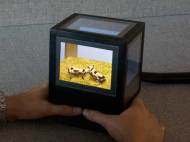pCubee – fish-tank-like 3D display requires no glasses
 The usual 3D technology uses a stereoscopic principle in which a slightly different image is presented to each eye. We already wrote about a 3D display with a rapidly spinning mirror, and in this article we’re going to write about a device named pCubee which gives you the experience of 3D in its own fashion. It was developed at the Human Communication Technologies Laboratory at the University of British Columbia in Canada.
The usual 3D technology uses a stereoscopic principle in which a slightly different image is presented to each eye. We already wrote about a 3D display with a rapidly spinning mirror, and in this article we’re going to write about a device named pCubee which gives you the experience of 3D in its own fashion. It was developed at the Human Communication Technologies Laboratory at the University of British Columbia in Canada.
pCubee consists of five 5-inch VGA (640×480 pixels) LCD screens arranged as a cubic “fish tank” box that viewers can pick up, tilt, shake or turn to watch the 3D content or play games with virtual objects that seem to be within the box. The display box measures 146 x 120 x 146 mm. The bottom side of the box is left open for ventilation and cables with a small 120 x 96 x 36 mm base to make it easier to grasp. The total weight of the frame, base, and screens is measured to be 1.3 kg (2.87 lbs).
Instead of stereoscopy, the device uses a principle called motion parallax – one of the means by which we usually perceive depth in a three dimensional scene. Motion parallax is a cue the brain is able to use to sense depth, because the movement of objects across our field of view depends on their relative distance from us. Having the box move means viewers do not need to move their heads to see the effect.
The five flat-panel LCD screens on the sides of the box are driven by three graphics pipelines. The perspective rendered on the screens is kept synchronized with the user’s view by a motion tracker that monitors both the user’s head and the pCubee box. The motion tracker and the real-time physics simulation engine, make the display look like a tank containing real objects. The box allows you to view a static 3D scene, or you can manipulate the box to navigate through the scene or play with objects colliding in the scene.
Leader of the engineering team, Sidney Fels, said the group wanted to offer “a fish-tank-like experience” in a handheld device. Fels hopes the pCubee will be commercially available soon, but the researchers are continuing to refine the design, and may replace the current LCD panels with OLED screens. They are also building pCubees in different sizes for different applications.
pCubee can be held in one hand while using another input device, such as a mouse or a 3D stylus, for bimanual control and performing precision work. The pCubee will have many more applications than 3D games, since it also has the potential to become a CAD-CAM platform, and could be used in museum displays. You can find more info in the paper they published: pCubee: A Perspective-Corrected Handheld Cubic Display (PDF).









Leave your response!